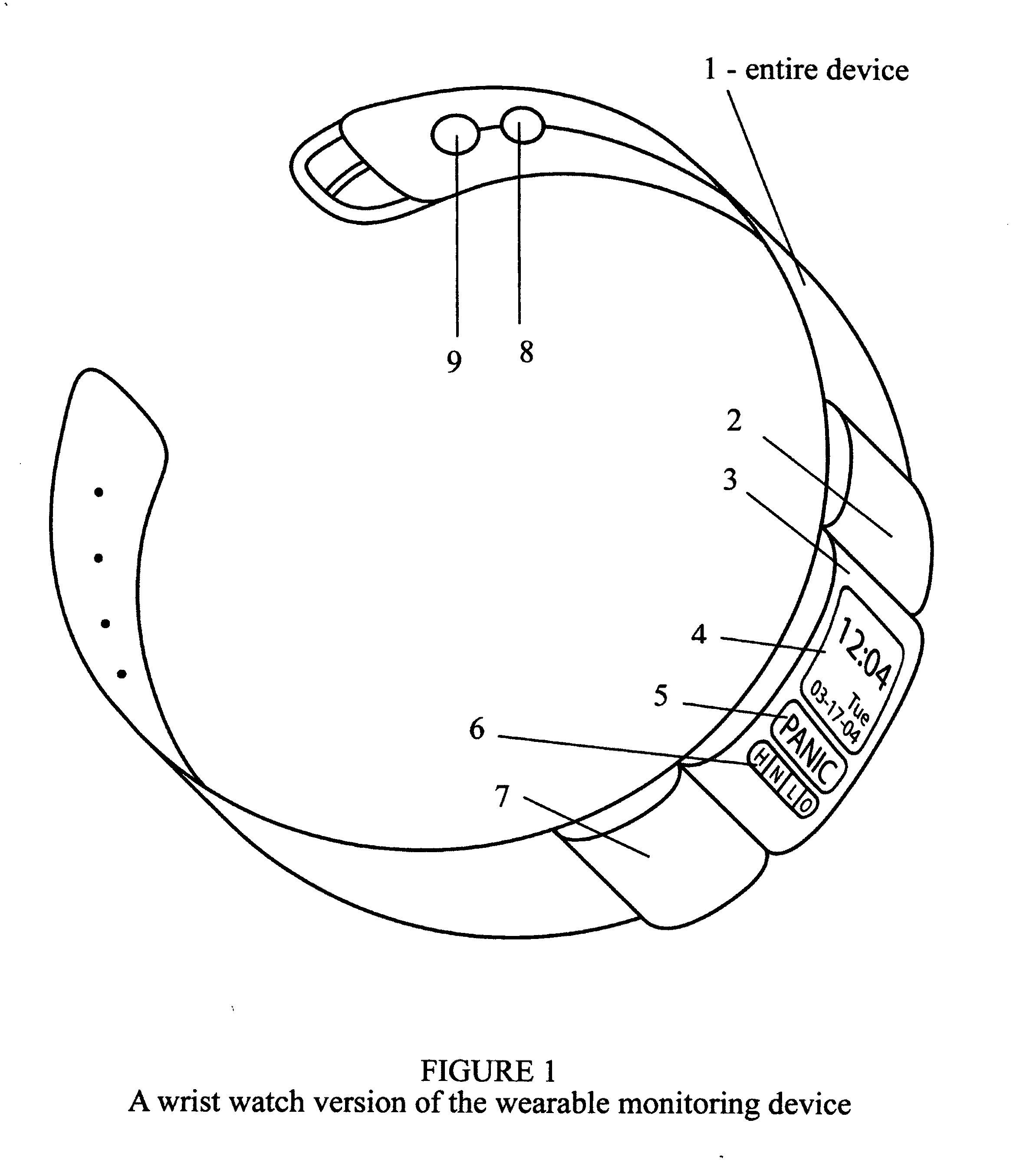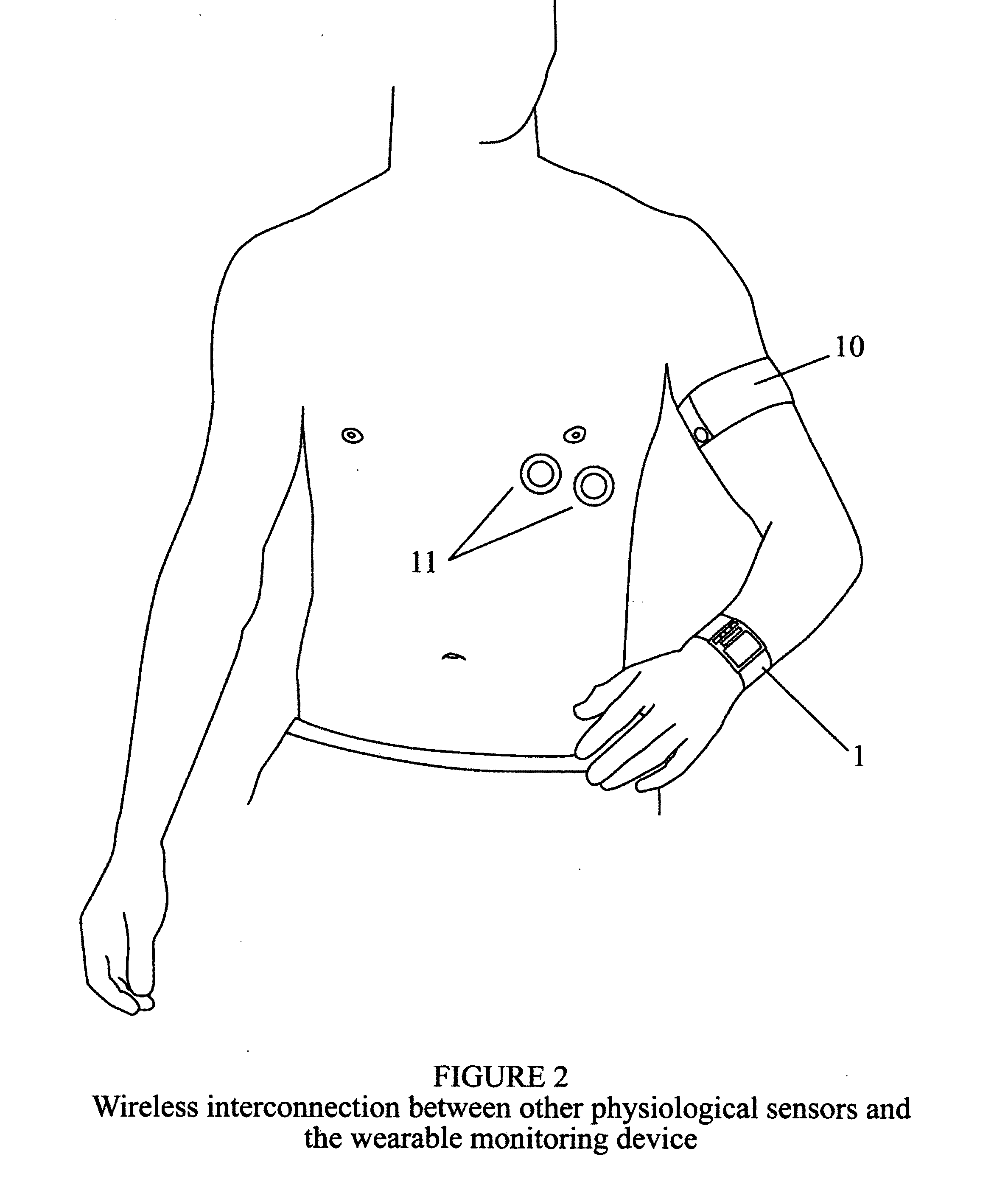Emergency health crises that require immediate attention have been a difficult problem to address regardless of the age of the person that is encountering a medical emergency situation.
However, if a person is disabled during a sudden health crisis, such as in a heart
attack, a
stroke or a serious fall situation, the
panic-button type devices become useless.
Consequently, the existing emergency reporting devices have only limited usefulness for the aging people and for those suffer special medical problems like Alzheimer's or
dementia.
This approach's weak points are the inability to determine a position when not receiving signals from more than one
satellite (due to shielding by buildings or geographic features or improper antenna orientation) as well as more power consuming
electronics.
None provide physiological measurements as a mean to determine whether a medical emergency situation has arisen, and none use abnormal physiological measurements as an automatic trigger to issue emergency alert and obtain immediate response without the person's manual effort of depressing a
panic button.
The
panic button approach that utilizes landline telephones to issue emergency alerts to a monitoring center restricts bearers to be within a specific distance of a base unit that dials the telephone; while approaches use cellular technology as communication conduits lack the means to specify the location of a bearer in need of emergency help without the person well enough to state where he / she is.
Neither of these approaches provides redundancy in ascertaining that an emergency alert reaches the monitoring center, nor any warning and diagnosis of malfunctions on the
system or devices within.
There are no continuous updates on the physiological measurements to facilitate a proper medical response.
Furthermore, all of them use
location determination methods without dealing with failure of these methods (such as unable to acquire multiple GPS
satellite signal to determine a location, location
confusion caused by multiple RF transmitters transmitting at the same time to an RF access points of WLAN, etc).
All of these prior arts report physiological measurements of an out-patient to a processor at a fixed location via wired or
wireless mean; the subject is tethered to a
processing unit, which, in turn, is itself physically connected to a communication network, thus limiting the area mobility of the subject.
Furthermore, these prior arts principally measure a
single patient and transmit the measured data to the targeted caregivers; consequently, no methodologies are devised to deal with identification of multiple patients and matching their physiological data accurately.
However, none deals with accurate matching of a person's physiological measurements with one's identity in an environment of multiple persons transmitting at the same time.
Also, none provide a fool-proof method of determining the location of the subject in need of medical
emergency response when freedom of movement is part of the system's essential features.
None provide a continuous update of the physiological measurements during the emergency reporting and time period before the arrival of a response team to give these responders relevant data to anticipate proper recourses to take.
Also, none of these prior arts provided redundancy in ascertaining that an emergency alert can reach the monitoring center, nor any warning and diagnosis of malfunctions on the system as well as its components.
Most important of all, none of the prior arts can furnish an adjustable medical
alert level due to change of physical conditions of a subject under monitoring throughout a day or due to anticipated action, such as change of
heart rate or
blood pressure caused by new medication to avoid
false alarm.
Also, this system does not provide continuous updates on the physiological conditions of the person in need of assistance.
This patent does not deal with how medical
alert status is first determined, nor does it deal with
location data of the person in stress.
Both of these prior arts do not employ physiological sensors to measure the medical condition of the subject as criteria for issuing alert automatically.
Furthermore, the
power consumption of this base unit dictates a physical connection to a power source for best
operating time length instead of using batteries.
However, this invention is not a medical monitoring or an emergency alert
reporting system; it also does not provide location information to any specific monitoring center.
Also, Chen's prior art does not provide an adjustable alert threshold to accommodate subjects with a variety of conditions and transient situations.
However, there are no physiological sensors to issue an automatic emergency alert; the person must carry the special
handset instead of wearing the sensor /
transceiver on the
wrist or arm; there is no provision for the lack of signals from multiple
GPS satellites and no fool-proof identification of the subject when there is interference from other persons' handsets when employing its stated WLAN method.
Since glucose
level measurement must involve manually pricking one's finger or arm to obtain a blood sample, this system is not automatic or transparent to the subject in providing monitoring and issuing emergency alert.
 Login to View More
Login to View More  Login to View More
Login to View More 


